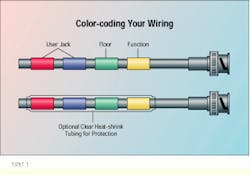Color-coding speeds cable identification
Bill Londell
ITT Avionics
Problem
Cable identification can be a maintenance nightmare. Electrical-wire number tags, string tags and masking tape tend to dry out and fall off eventually. Number tags are another alternative, but they can be difficult to locate because the cable you are looking for invariably has the label facing away, and it is often placed too close to the connector. Sending a tone over a cable sometimes helps to locate it, but this procedure is not effective in an electrically noisy environment. Too often, then, the maintenance department would rather run a new cable than try to locate the end of an existing one.
Custom-label makers have excellent products, but the labels are expensive and usually do not stick well if they have been dropped. And you always seem to run out of label tapes when you need them most.
Solution
Colored tape can be a solution to the problem of wire identification, making locating cables from a distance easier. Such tapes are inexpensive, and electricians generally have the basic colors on hand.
You can use two of the 10 basic colors of electrical tape, resulting in 100 color-coding combinations (10x10). Using three colors results in 1000 combinations (10x10x10).
Another benefit of colored tapes is that you can use different colors to represent functions or departments. For instance, the first color on a wire (nearest the termination) may designate the function, the second the floor, the third the department and the remaining colors the wire identification.
For example, blue in the first position may represent voice and red may signify data. Ten colors in the second position may represent the 10 digits, to signify the floor number in the building. In the third and fourth positions, the same color-to-number scheme can be used to identify user jack or office number.
Obviously, the underlying wire color has to be taken into consideration when you are designing your color-coding scheme.
Procedure
1) Design a color-coding scheme that will work with your installation and add it to the database or spreadsheet that documents your cable plant.
2) Carry the tapes in a container so they are handy and can stay clean.
3) You may also want to cut lengths of tape and stick them to a vinyl sheet protector, which makes them handy to carry. The sheets can easily be placed in a notebook or toolkit.
4) Cut a length of tape and wrap it around the wire. It should extend for at least two full turns.
5) If the location of the wire leaves it prone to physical or chemical abuse, place a piece of clear shrink-tubing over it to cover the tapes before you
terminate or connnectorize the end.
Try not to color-code too close to the end of the cable in case you have to cut it back and reterminate.
Colored tapes wrapped securely around telecommunications cabling are visible from a distance and can represent different things--function, floor, department and user jack. Heat-shrink tubing protects the tapes in a hostile environment.
Bill Londell is a networking technical specialist at ITT Avionics, Clifton, NJ.

